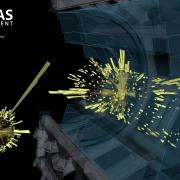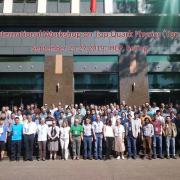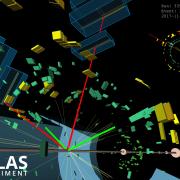Access to Collaboration Site and Physics Results

In 2015, in the first proton-proton collision data at a centre-of-mass energy of 13 TeV, the ATLAS collaboration observed more events than expected around the 750 GeV mass window. A modest peak emerged from the smoothly falling mass distribution of background processes predicted by the Standard Model. The maximum significance of this excess for a new physics particle with a large intrinsic width was 3.9 sigma, i.e. the chances that the background alone would fluctuate by this amount or more at that specific mass was about 1 in 10,000. However, the chance that the background fluctuates in any of the mass or width hypotheses included in the search was about 2 sigma, i.e. 1 in 50.
The 2015 analysis was optimised for a Higgs-like scalar particle (“spin-0”) or graviton-like particle (“spin-2”), which would lead to photons with different distributions in the ATLAS detector. Photons are precisely measured by the ATLAS calorimeter and provide an excellent mass resolution of the di-photon system. Thus the search for new particles can be carried out in fine mass bins and for various signal widths. Moreover, the background can be reliably estimated using a control region at lower and higher masses.
Last year’s result triggered lively discussions in the scientific communities about possible explanations in terms of new physics and the possible production of a new, beyond-Standard Model particle decaying to two photons. However, with the modest statistical significance from 2015, only more data could give a conclusive answer.
This year, the ATLAS experiment has benefited from an extraordinary performance by the LHC, with peak numbers of collisions going beyond design values. The 2016 collected dataset is already four times bigger than the one taken in 2015. In anticipation of a new analysis of the excess, ATLAS physicists carefully prepared these new data, introducing improvements to the photon reconstruction and making sure that the data taken in 2015 and 2016 could be treated as one dataset.

New results from the combined dataset were presented at the ICHEP conference in Chicago on Friday, 5 August. This new analysis includes data taken up to 17 July, 2016. The large dataset allowed ATLAS to record di-photon events at much larger invariant masses; the event with the highest recorded invariant mass is at 2.2 TeV.
The 2016 analysis follows closely that of 2015, and at this time includes the spin-0 search analysis. With the very latest data at record luminosities, a large number of additional collisions (pile-up) were produced. Thus more work is needed to complete the analysis in the extended acceptance of the spin-2 selection.
At the mass and width corresponding to the largest deviations from the background-only hypothesis in the 2015 data, no large excess is observed in the 2016 data. The excess at an invariant mass of 750 GeV as seen in the 2015 data is therefore not confirmed with the 2016 data. The compatibility of the 2015 and 2016 datasets, assuming a signal with mass and width given by the largest 2015 excess, is on the level of 2.7 sigma. This suggests that the observation in the 2015 data was an upward statistical fluctuation.
At the mass and width corresponding to the largest deviations from the background-only hypothesis in the 2015 data, no large excess is observed in the 2016 data.
Using the combined 2015 and 2016 data, ATLAS physicists have derived upper limits on the production cross-section of hypothetical new particles. For a particle with a narrow width, the upper cross-section limits are 1 fb for a mass of 0.5 TeV and 0.2 fb for a mass of 2 TeV.
The lack of a signal in the 2016 data does not come as a surprise. With the large number of searches for new particles that ATLAS performs, we are guaranteed to occasionally see excesses in some regions of some analyses purely from statistical fluctuations. The broad external interest in our 2015 result is indicative of the very strong power of the LHC physics programme. With the accumulating 2016 dataset, ATLAS is rapidly expanding its capacity to identify and explore any physics beyond the Standard Model that nature may have in store for us. We look forward with excitement to robust discoveries in the coming years.

Links:
- Searches for high mass diphoton resonances (ATLAS-CONF-2016-059): https://atlas.web.cern.ch/Atlas/GROUPS/PHYSICS/CONFNOTES/ATLAS-CONF-2016-059/
- Find all ATLAS 13 TeV results for 2016 summer conferences: https://twiki.cern.ch/twiki/bin/view/AtlasPublic/Summer2016-13TeV








